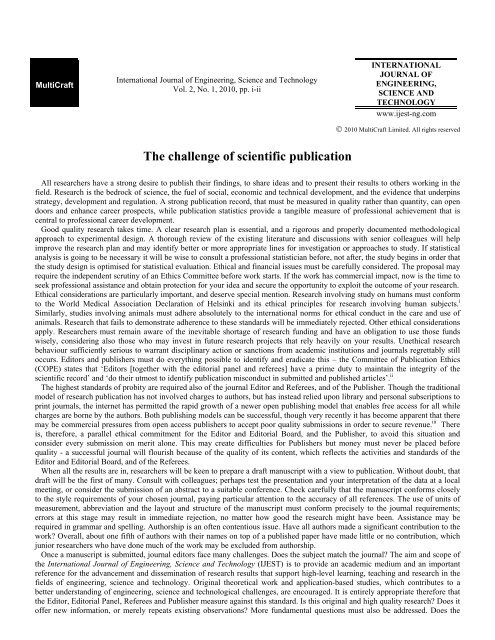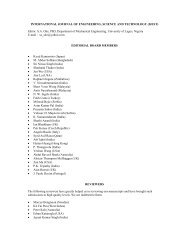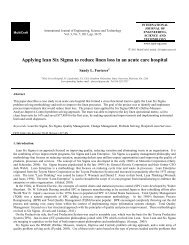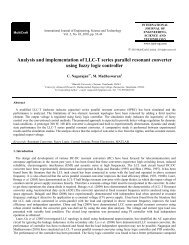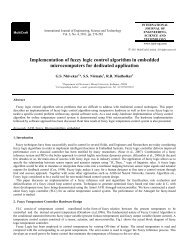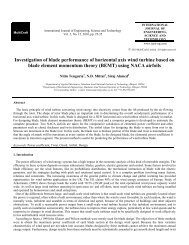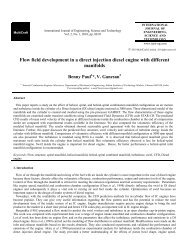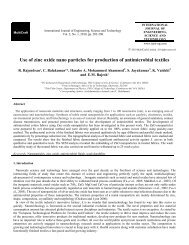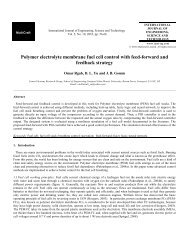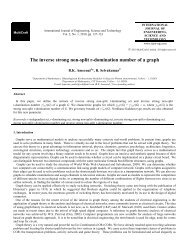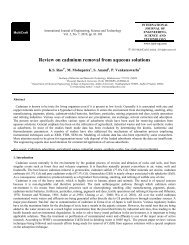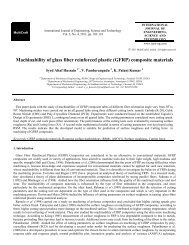Full Text (PDF) - International Journal of Engineering, Science and ...
Full Text (PDF) - International Journal of Engineering, Science and ...
Full Text (PDF) - International Journal of Engineering, Science and ...
You also want an ePaper? Increase the reach of your titles
YUMPU automatically turns print PDFs into web optimized ePapers that Google loves.
MultiCraft<br />
<strong>International</strong> <strong>Journal</strong> <strong>of</strong> <strong>Engineering</strong>, <strong>Science</strong> <strong>and</strong> Technology<br />
Vol. 2, No. 1, 2010, pp. i-ii<br />
INTERNATIONAL<br />
JOURNAL OF<br />
ENGINEERING,<br />
SCIENCE AND<br />
TECHNOLOGY<br />
www.ijest-ng.com<br />
© 2010 MultiCraft Limited. All rights reserved<br />
The challenge <strong>of</strong> scientific publication<br />
All researchers have a strong desire to publish their findings, to share ideas <strong>and</strong> to present their results to others working in the<br />
field. Research is the bedrock <strong>of</strong> science, the fuel <strong>of</strong> social, economic <strong>and</strong> technical development, <strong>and</strong> the evidence that underpins<br />
strategy, development <strong>and</strong> regulation. A strong publication record, that must be measured in quality rather than quantity, can open<br />
doors <strong>and</strong> enhance career prospects, while publication statistics provide a tangible measure <strong>of</strong> pr<strong>of</strong>essional achievement that is<br />
central to pr<strong>of</strong>essional career development.<br />
Good quality research takes time. A clear research plan is essential, <strong>and</strong> a rigorous <strong>and</strong> properly documented methodological<br />
approach to experimental design. A thorough review <strong>of</strong> the existing literature <strong>and</strong> discussions with senior colleagues will help<br />
improve the research plan <strong>and</strong> may identify better or more appropriate lines for investigation or approaches to study. If statistical<br />
analysis is going to be necessary it will be wise to consult a pr<strong>of</strong>essional statistician before, not after, the study begins in order that<br />
the study design is optimised for statistical evaluation. Ethical <strong>and</strong> financial issues must be carefully considered. The proposal may<br />
require the independent scrutiny <strong>of</strong> an Ethics Committee before work starts. If the work has commercial impact, now is the time to<br />
seek pr<strong>of</strong>essional assistance <strong>and</strong> obtain protection for your idea <strong>and</strong> secure the opportunity to exploit the outcome <strong>of</strong> your research.<br />
Ethical considerations are particularly important, <strong>and</strong> deserve special mention. Research involving study on humans must conform<br />
to the World Medical Association Declaration <strong>of</strong> Helsinki <strong>and</strong> its ethical principles for research involving human subjects. i<br />
Similarly, studies involving animals must adhere absolutely to the international norms for ethical conduct in the care <strong>and</strong> use <strong>of</strong><br />
animals. Research that fails to demonstrate adherence to these st<strong>and</strong>ards will be immediately rejected. Other ethical considerations<br />
apply. Researchers must remain aware <strong>of</strong> the inevitable shortage <strong>of</strong> research funding <strong>and</strong> have an obligation to use those funds<br />
wisely, considering also those who may invest in future research projects that rely heavily on your results. Unethical research<br />
behaviour sufficiently serious to warrant disciplinary action or sanctions from academic institutions <strong>and</strong> journals regrettably still<br />
occurs. Editors <strong>and</strong> publishers must do everything possible to identify <strong>and</strong> eradicate this – the Committee <strong>of</strong> Publication Ethics<br />
(COPE) states that ‘Editors [together with the editorial panel <strong>and</strong> referees] have a prime duty to maintain the integrity <strong>of</strong> the<br />
scientific record’ <strong>and</strong> ‘do their utmost to identify publication misconduct in submitted <strong>and</strong> published articles’. ii<br />
The highest st<strong>and</strong>ards <strong>of</strong> probity are required also <strong>of</strong> the journal Editor <strong>and</strong> Referees, <strong>and</strong> <strong>of</strong> the Publisher. Though the traditional<br />
model <strong>of</strong> research publication has not involved charges to authors, but has instead relied upon library <strong>and</strong> personal subscriptions to<br />
print journals, the internet has permitted the rapid growth <strong>of</strong> a newer open publishing model that enables free access for all while<br />
charges are borne by the authors. Both publishing models can be successful, though very recently it has become apparent that there<br />
may be commercial pressures from open access publishers to accept poor quality submissions in order to secure revenue. iii There<br />
is, therefore, a parallel ethical commitment for the Editor <strong>and</strong> Editorial Board, <strong>and</strong> the Publisher, to avoid this situation <strong>and</strong><br />
consider every submission on merit alone. This may create difficulties for Publishers but money must never be placed before<br />
quality - a successful journal will flourish because <strong>of</strong> the quality <strong>of</strong> its content, which reflects the activities <strong>and</strong> st<strong>and</strong>ards <strong>of</strong> the<br />
Editor <strong>and</strong> Editorial Board, <strong>and</strong> <strong>of</strong> the Referees.<br />
When all the results are in, researchers will be keen to prepare a draft manuscript with a view to publication. Without doubt, that<br />
draft will be the first <strong>of</strong> many. Consult with colleagues; perhaps test the presentation <strong>and</strong> your interpretation <strong>of</strong> the data at a local<br />
meeting, or consider the submission <strong>of</strong> an abstract to a suitable conference. Check carefully that the manuscript conforms closely<br />
to the style requirements <strong>of</strong> your chosen journal, paying particular attention to the accuracy <strong>of</strong> all references. The use <strong>of</strong> units <strong>of</strong><br />
measurement, abbreviation <strong>and</strong> the layout <strong>and</strong> structure <strong>of</strong> the manuscript must conform precisely to the journal requirements;<br />
errors at this stage may result in immediate rejection, no matter how good the research might have been. Assistance may be<br />
required in grammar <strong>and</strong> spelling. Authorship is an <strong>of</strong>ten contentious issue. Have all authors made a significant contribution to the<br />
work? Overall, about one fifth <strong>of</strong> authors with their names on top <strong>of</strong> a published paper have made little or no contribution, which<br />
junior researchers who have done much <strong>of</strong> the work may be excluded from authorship.<br />
Once a manuscript is submitted, journal editors face many challenges. Does the subject match the journal? The aim <strong>and</strong> scope <strong>of</strong><br />
the <strong>International</strong> <strong>Journal</strong> <strong>of</strong> <strong>Engineering</strong>, <strong>Science</strong> <strong>and</strong> Technology (IJEST) is to provide an academic medium <strong>and</strong> an important<br />
reference for the advancement <strong>and</strong> dissemination <strong>of</strong> research results that support high-level learning, teaching <strong>and</strong> research in the<br />
fields <strong>of</strong> engineering, science <strong>and</strong> technology. Original theoretical work <strong>and</strong> application-based studies, which contributes to a<br />
better underst<strong>and</strong>ing <strong>of</strong> engineering, science <strong>and</strong> technological challenges, are encouraged. It is entirely appropriate therefore that<br />
the Editor, Editorial Panel, Referees <strong>and</strong> Publisher measure against this st<strong>and</strong>ard. Is this original <strong>and</strong> high quality research? Does it<br />
<strong>of</strong>fer new information, or merely repeats existing observations? More fundamental questions must also be addressed. Does the
ii<br />
Blenkharn ./ <strong>International</strong> <strong>Journal</strong> <strong>of</strong> <strong>Engineering</strong>, <strong>Science</strong> <strong>and</strong> Technology, Vol. 2, No. 1, 2010, pp. i-ii<br />
work meet all m<strong>and</strong>atory ethical st<strong>and</strong>ards? Is there evidence <strong>of</strong> plagiarism, or <strong>of</strong> duplicate publication? If all appears well, Editors<br />
will invite two or more independent Referees to examine the manuscript. Referees will be senior scientists with experience in the<br />
area <strong>of</strong> study. They should be detached from the study <strong>and</strong> host institution, <strong>and</strong> must declare immediately any conflict <strong>of</strong> interest.<br />
To ensure properly blind peer review, Referees will be unaware <strong>of</strong> the identity <strong>of</strong> the author(s) <strong>and</strong> their host institution as that<br />
information will be stripped from the manuscript before distribution.<br />
The role <strong>of</strong> the Referee is to provide specialist advice to the Editor, mainly regarding the quality <strong>of</strong> the research <strong>and</strong> st<strong>and</strong>ard <strong>of</strong><br />
presentation <strong>of</strong> the manuscript. Referees or Peer Reviewers may <strong>of</strong>fer specific advice regarding improvements in style, the use <strong>of</strong><br />
tables <strong>and</strong> charts, <strong>and</strong> can suggest improvements or identify weaknesses that require additional work. They must be impartial in<br />
their examination <strong>of</strong> submitted manuscripts. Referees will be selected for their experience in a particular field; Editors will<br />
generally invite at least two <strong>and</strong> <strong>of</strong>ten three reviewers to examine each manuscript to ensure diversity <strong>of</strong> opinion <strong>and</strong> eliminate<br />
bias. Referees <strong>and</strong> Editors are generally busy people with full time jobs in addition to these additional duties <strong>and</strong> cannot, <strong>and</strong><br />
generally will not, provide extensive <strong>and</strong> detailed assistance to rewrite a defective manuscript. Most Referees will quickly detect<br />
submissions that are grossly incomplete or inadequate <strong>and</strong> for those rejection is likely. For those manuscripts showing promise,<br />
immediate acceptance is unlikely as almost always there will be need for some clarification or correction or some further<br />
improvements. For other manuscripts, more extensive work may be required <strong>and</strong> Referees should <strong>of</strong>fer clear guidance <strong>and</strong><br />
reasoning for their concerns, with an invitation to resubmit the manuscript within a few weeks or months depending on the nature<br />
<strong>of</strong> the revisions required.<br />
Be prepared for some difficult questions. Referees will search for incomplete or inconsistent data, may expect greater detail <strong>and</strong><br />
additional clarification, or a shorter <strong>and</strong> more succinct presentation. The author’s view <strong>of</strong> clarity will <strong>of</strong>ten differ from that <strong>of</strong> the<br />
Referee, who may dem<strong>and</strong> further detail. What does ‘ordinary’ mean, define ‘regular’, how normal is ‘normal’, what is ‘usual’, or<br />
‘average’ or ‘typical’? Data presented in Tables or Figures should not be repeated in the text. A particularly common error is a<br />
failure to address some earlier but highly relevant publications, especially where this is contradictory to the current findings, or to<br />
misquote references <strong>and</strong> take the findings <strong>of</strong> others out <strong>of</strong> their intended context. It is perfectly acceptable to express a different<br />
opinion or to move away from established theory, but to do so needs the backing <strong>of</strong> a meticulously presented hypothesis, sound<br />
reasoning <strong>and</strong> almost certainly a substantial body <strong>of</strong> rigorously conducted experimental evidence to support an alternate<br />
hypothesis. Do make certain that all experimental data is properly documented <strong>and</strong> retained for scrutiny, ever after publication <strong>of</strong><br />
your manuscript. An important aspect <strong>of</strong> the publishing process is the essential declaration <strong>of</strong> conflicts <strong>of</strong> interest. Think carefully<br />
about this. Who funded or supported the work? Was there any input from commercial sponsors, <strong>and</strong> what links exist between the<br />
authors <strong>and</strong> those with a commercial interest in the study?<br />
At every stage, the Editor <strong>and</strong> Referees will be diligent to the possibility <strong>of</strong> research fraud. Plagiarism is unacceptable, <strong>and</strong><br />
though the work <strong>of</strong> others can <strong>and</strong> probably will be cited in your own manuscript, this should be properly referenced. Simply<br />
copying the work <strong>of</strong> others is totally unacceptable <strong>and</strong> will inevitably result in an investigation that may involve the Editorial<br />
Board liaising with the senior <strong>of</strong>ficers <strong>of</strong> the authors’ host institution or pr<strong>of</strong>essional body. Duplicate publication is similarly<br />
unacceptable, though regrettably this still occurs as authors play the ‘numbers game’ to increase the number <strong>of</strong> publications <strong>and</strong><br />
exp<strong>and</strong> their Curriculum vitae. This distorts or skews the literature <strong>and</strong> misleads fellow researchers. Research fraud is a serious<br />
matter, <strong>and</strong> even if it escapes detection during the rigorous refereeing process wider scrutiny by the <strong>Journal</strong> readers may identify<br />
issues not previously apparent, leading to investigation <strong>and</strong> a formal retraction even years later.<br />
Despite all <strong>of</strong> these very many hurdles, some proportion <strong>of</strong> submitted manuscripts will be ready for publication. Take care with<br />
the final preparation <strong>of</strong> typescripts <strong>and</strong> check pro<strong>of</strong>s with the greatest care. This is the last change to correct any errors or<br />
inaccuracies. Only then is it time to sit back with pride at your success in overcoming all <strong>of</strong> the very many hurdles that must be<br />
faced when considering scientific publication. But self-congratulation cannot last for long as the next research project may already<br />
be in progress <strong>and</strong> we at the <strong>International</strong> <strong>Journal</strong> <strong>of</strong> <strong>Engineering</strong>, <strong>Science</strong> <strong>and</strong> Technology (IJEST) will look forward to your next<br />
submission.<br />
J Ian Blenkharn<br />
Consultant Healthcare <strong>and</strong> Environmental Microbiologist<br />
Blenkharn Environmental, London<br />
i<br />
ii<br />
iii<br />
World Medical Association. Declaration <strong>of</strong> Helsinki: Ethical Principles for Medical Research Involving Human Subjects.<br />
http://www.wma.net/e/policy/b3.htm (accessed 19 July 2009)<br />
Committee on Publication Ethics (COPE). COPE code <strong>of</strong> conduct. http://publicationethics.org/code-conduct (accessed 19<br />
July 2009)<br />
Grant B. OA publisher accepts fake paper. http://www.the-scientist.com/blog/display/55756/ (accessed 19 July 2009)


